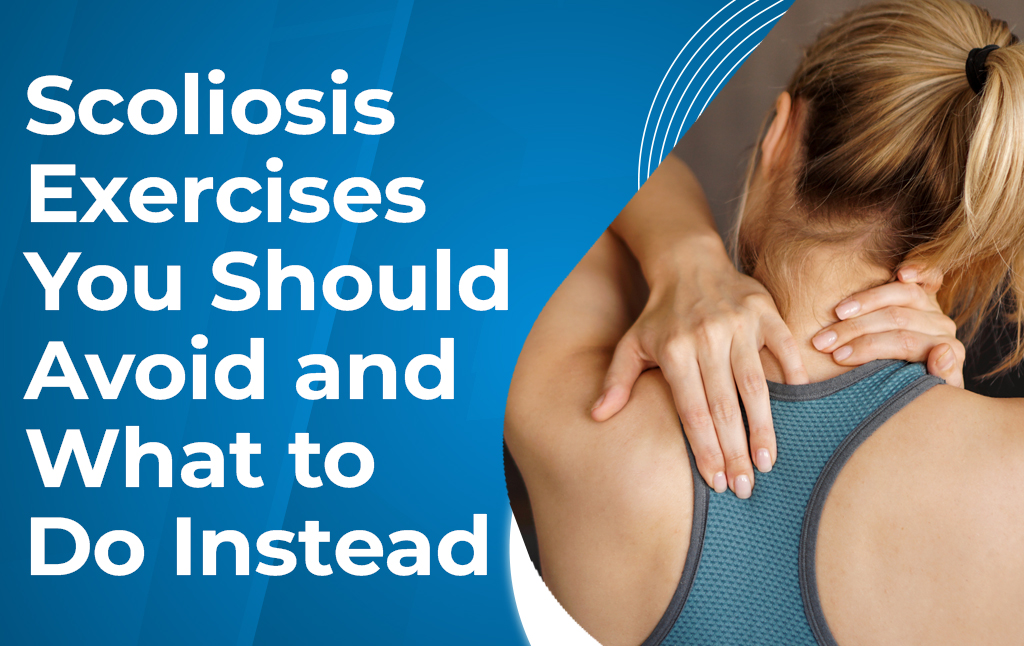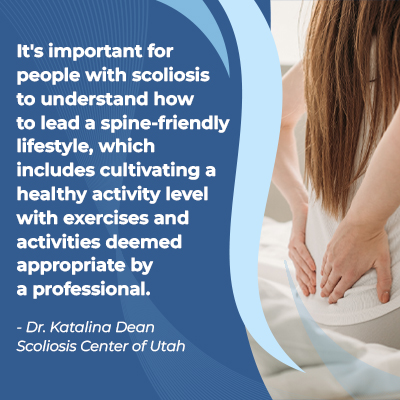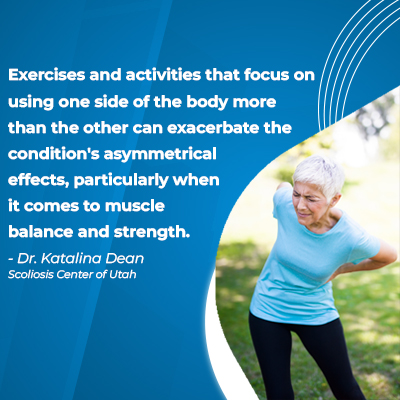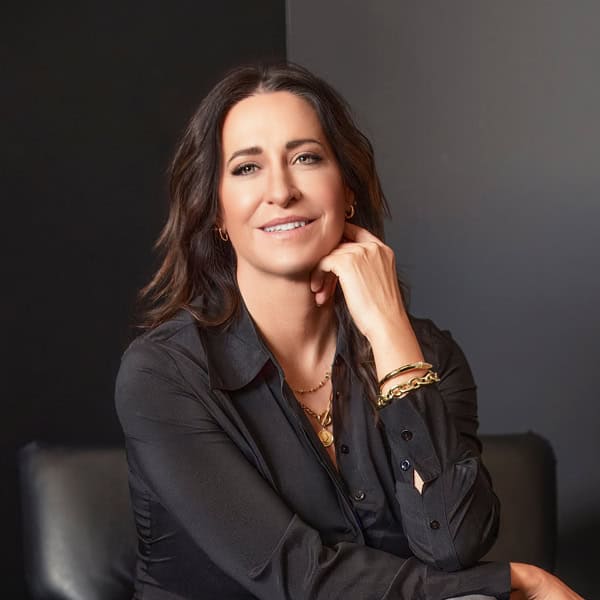Blogs
Scoliosis Exercises You Should Avoid and What to Do Instead

Scoliosis exercises can have therapeutic and corrective potential, but it’s important to understand the limitations of a spine with scoliosis Exercises and activities that overuse one side of the body, expose the spine to repeated shock from impact, and involve straining the spine should be avoided.
Scoliosis exercises to avoid are those that strain the spine; exercises that are scoliosis-specific and combined with other facets of treatment can help restore balance to the spine and strengthen its surrounding muscles for more support.
Before getting to specific exercises and activities people with scoliosis should avoid, let’s talk about how scoliosis affects the spine and its surroundings.
Scoliosis and Spinal Health
Scoliosis causes the spine to bend unnaturally to the side, and its rotational component makes the condition 3-dimensional.
The spine’s healthy curves make it stronger and more functional, but when the spine loses a healthy curve, problems can occur within and around the spine; in fact, a spine that’s misaligned due to a loss of its healthy curves can disrupt the entire body’s alignment from the head to the feet.
The spine’s design is based on strength, flexibility, and movement.
As scoliosis develops, uneven forces are affecting the spine and body, making it difficult to maintain good posture, and as a progressive condition, its effects can get worse over time.
The main symptoms of scoliosis in children involve postural deviation such as uneven shoulders and hips; the main symptoms of adult scoliosis is pain caused by compression.
Scoliosis has been around since ancient times, and we’ve learned a lot about the condition and treatment efficacy over the years, including the place of exercise in scoliosis treatment.
While no exercise routine should be adopted without being approved by a scoliosis patient’s treatment provider, exercise can help with general spinal health, and when it’s scoliosis-specific and customized by a scoliosis-specific physical therapist, it can be a powerful facet of non-surgical scoliosis treatment.
 It’s important for people with scoliosis to understand how to lead a spine-friendly lifestyle, which includes cultivating a healthy activity level with exercises and activities deemed appropriate by a professional.
It’s important for people with scoliosis to understand how to lead a spine-friendly lifestyle, which includes cultivating a healthy activity level with exercises and activities deemed appropriate by a professional.
Exercises to Avoid with Scoliosis
People with scoliosis have spines that can be weaker, less flexible, and more vulnerable to injury, so certain exercises and activities should be approached with caution and/or avoided entirely.
When it comes to activities and exercises to avoid with scoliosis, these include those that overuse one side of the body, expose the spine to more compression and repeated shock from impact, and place the spine in an unnatural position, straining it.
Exercises that are deemed appropriate for people with scoliosis can help with pain management, improving core strength for more spinal support, increasing spinal flexibility, and making it more responsive to treatment.
The use of scoliosis-specific mirror-image exercises can help with postural awareness and remodeling: teaching patients how to position their spine and body during various activities, which also helps with holding treatment results for long-term improvement.
Scoliosis is an asymmetrical condition so disrupts the body’s overall symmetry and balance.
One of the potential effects of scoliosis is a muscular imbalance as the unnatural spinal curve pulls the muscles that surround the spine in different directions.
The muscles on one side of the spine can become sore and tight from having to support the unnatural spinal curve and being overused, while muscles on the opposite side can become weak from lack of use.
 Exercises and activities that focus on using one side of the body more than the other can exacerbate the condition’s asymmetrical effects, particularly when it comes to muscle balance and strength.
Exercises and activities that focus on using one side of the body more than the other can exacerbate the condition’s asymmetrical effects, particularly when it comes to muscle balance and strength.
So sports like tennis and bowling should be approached with caution and/or avoided because they focus on one side of the body.
Part of a proactive treatment plan involves improving the spine’s surrounding core muscles strength, balance, and core exercises like pelvic tilts and planking can be effective strengthening exercises that work the muscles symmetrically.
Repeated Shock and Strain
Scoliosis becomes compressive once skeletal maturity has been reached, and compression is uneven pressure.
It’s compression of the spine and its surroundings that causes back and radiating pain in adults.
Exercises to avoid include those that expose the spine to repeated stress from impact, repeatedly compressing the spine such as contact sports (football), long jump, and horseback riding.
Dead lifting weights straight over the head should also be avoided because this adds weight and pressure to the spine and can strain it, leading to injury.
Certain weightlifting exercises can be modified, but they need to be customized by a professional based on a patient’s ability, condition severity, type, and the location of the scoliosis.
Spinal Position
Scoliosis causes certain vertebrae (bones of the spine) to become unnaturally tilted, and this shifts them out of alignment with the rest of the spine, so exercises that place the spine in an unnatural position should also be avoided.
Hyperextending the spine means it’s stretched to the point where certain vertebrae can rotate further into an unhealthy spinal curve, exacerbating the condition’s rotational component.
So activities and exercises that involve extending the torso can mean an unhealthy position for the thoracic spine; deep back bends used in certain yoga positions, gymnastics, diving, and certain dance styles should be avoided.
While certain swimming strokes (butterfly and breast stroke) are considered less ideal for people with scoliosis, in general, casual swimming and water therapy can be a helpful exercise for scoliosis because the weightless environment relieves pressure on the spine, it can work the body’s muscles symmetrically, and is low impact.
Walking is also a healthy exercise for scoliosis because it can be done while the spine is held in a neutral position, is low impact, and can help increase strength, maintain flexibility, and improve circulation (good for the discs of the spine).
So while there are many exercises and activities that need to be modified or avoided completely, it’s important for people with scoliosis to understand that staying active is crucial; not only can it help keep the spine flexible and responsive, it can also mean improving posture and core strength for optimal spinal support and stability.
ScoliBalance® Therapy
The power of exercise for scoliosis patients can be profound; in fact, there are entire exercise-based treatment approaches, with proven results, that can offer patients 3-D correction (the Schroth method and SEAS Scientific Exercise Approach to Scoliosis).
While the methodology can differ between the various exercise-based approaches to scoliosis correction, the goal is the same: to address all levels of the 3D spinal deformity by improving the spine’s alignment, but also the alignment of the shoulders, rib cage and pelvis by restoring proper anatomical posture.
Here at the Scoliosis Center of Utah, ScoliBalance® therapy involves the prescription of scoliosis-specific exercises and rehabilitation, and when it’s combined with Chiropractic BioPhysics® and the ScoliBrace® solution, scoliosis can be addressed on every level.
ScoliBalance® therapy involves crafting an individualized scoliosis-specific exercise program based on a patient’s curve type, posture, and experienced symptoms.
The use of mirror-image exercises is a focus of ScoliBalance® as patients are taught postural awareness and how proper body positioning can help hold treatment results and improve the spine’s biomechanics.
Conclusion
It’s not easy being diagnosed with a progressive spinal condition and knowing its effects are likely to become worse over time.
Particularly with young athletes recently diagnosed, I’m met with concerns about their ability to continue with certain sports, activities, and types of exercise.
What I remind a lot of these patients is that there are a number of celebrities and professional athletes who have fulfilled their life’s goals, despite being diagnosed with scoliosis years before, and we also know more about scoliosis than ever so can modify a number of exercises and activities to make them appropriate.
Exercises and activity recommendations/restrictions will be case-specific, but in general, exercises and activities to avoid include those that involve repeated shock from impact like football, long jump, and horseback riding.
Sports that overuse one side of the body can worsen the condition’s asymmetrical effects so should also be avoided.
Any exercise that strains the spine can make it vulnerable to injury, such as dead lifting weight straight over the head, should be avoided because a spine with scoliosis is already weaker and more vulnerable to injury.
Strengthening exercises that are low impact, encourage good posture, and involve the spine being held in a neutral and aligned position can help with treatment and pain management.
So if you’ve been diagnosed with scoliosis, knowing a few exercises that can help with general flexibility and strength can be helpful, and when committing to a proactive non-surgical treatment approach, ScoliBalance® therapy, chiropractic adjustments, and corrective bracing can work together to re-balance the spine and body.

Dr. Katalina Dean
Dr. Katalina Dean is the founder and clinical director of Scoliosis Center of Utah, in Midvale, UT. Her team specializes in posture correction, spinal rehabilitation, and non-invasive scoliosis care and bracing.
Call Today
Do You Qualify for Care?
Schedule an Appointment Below
